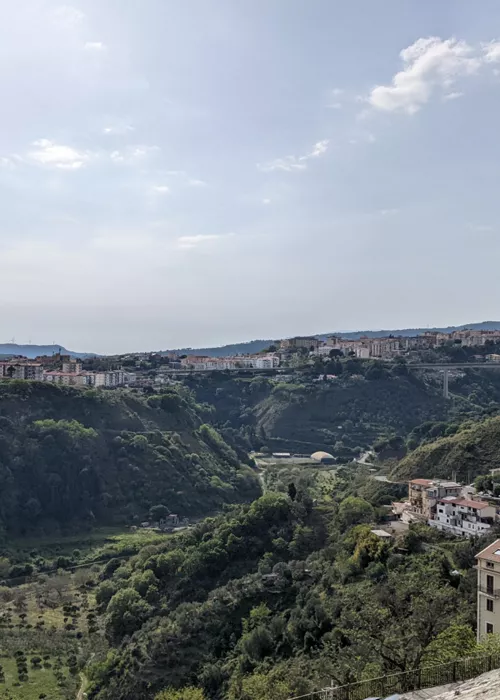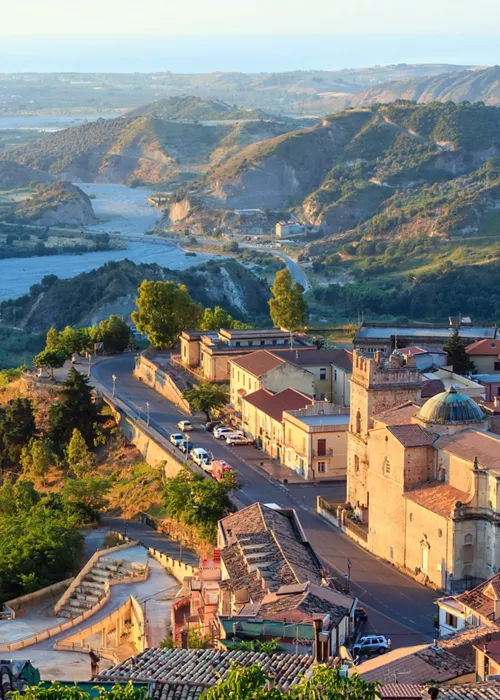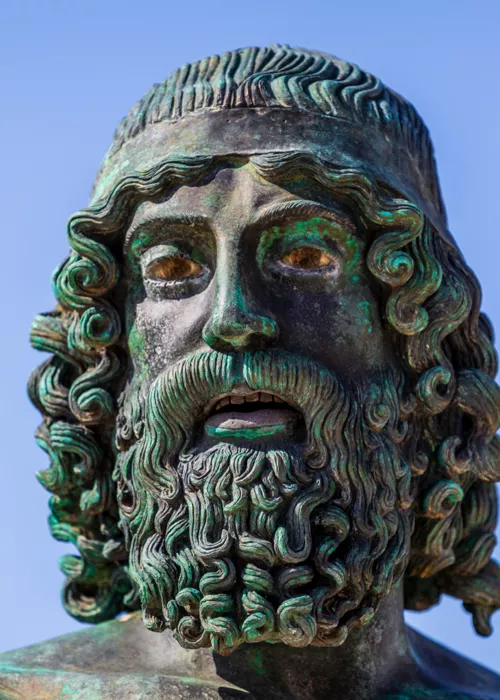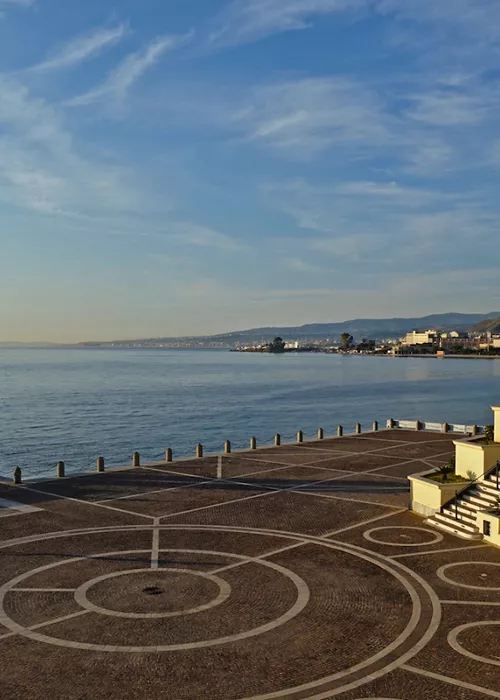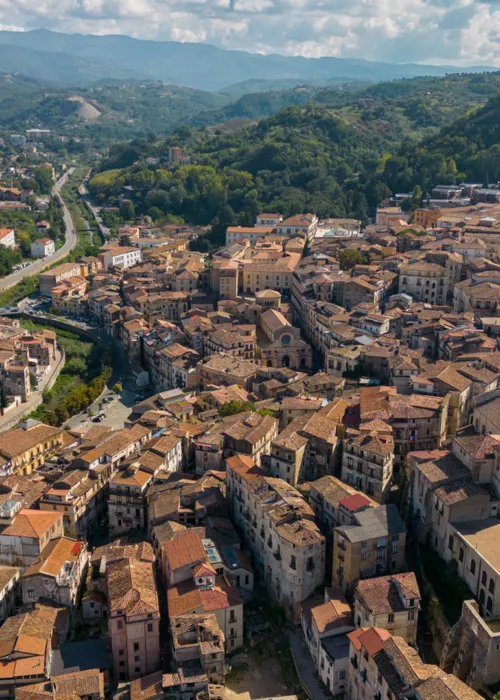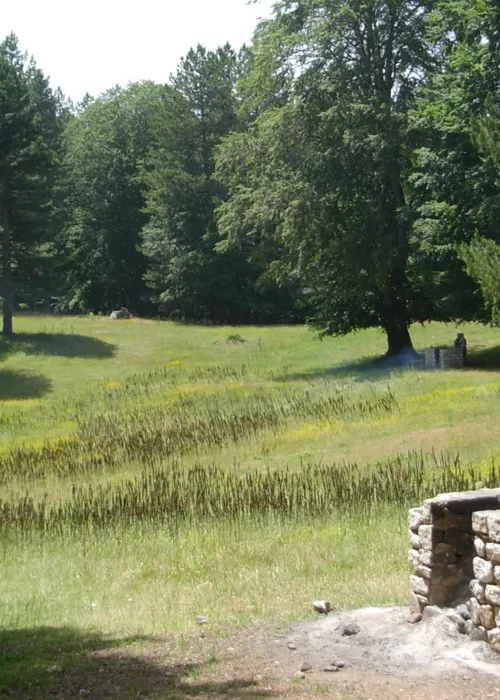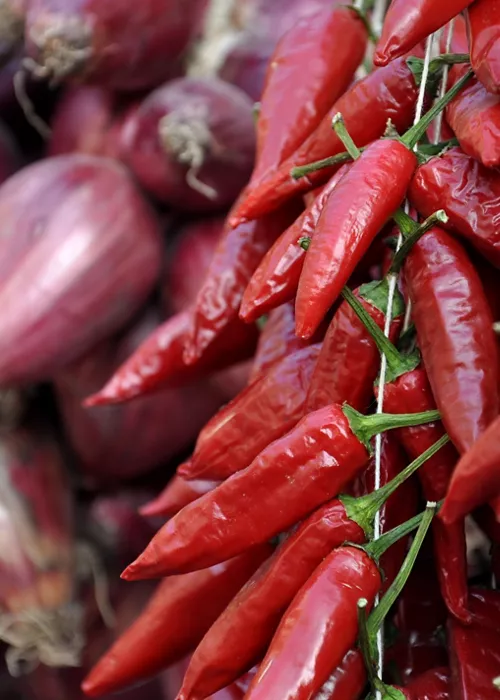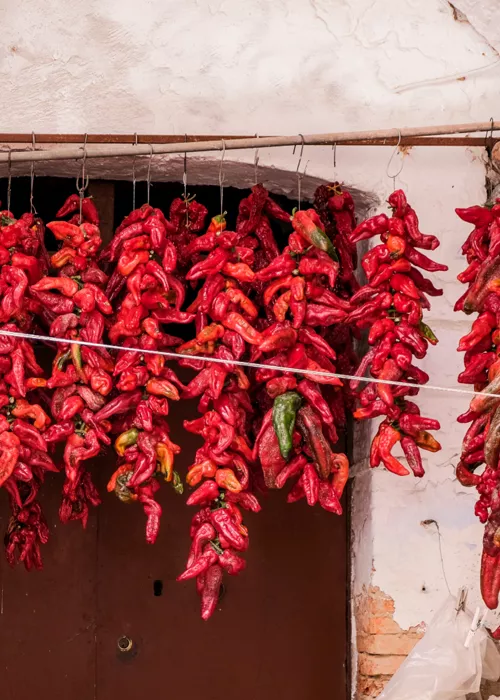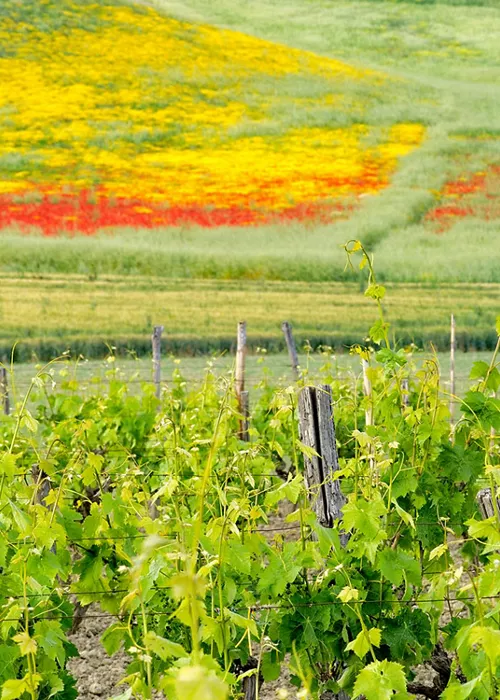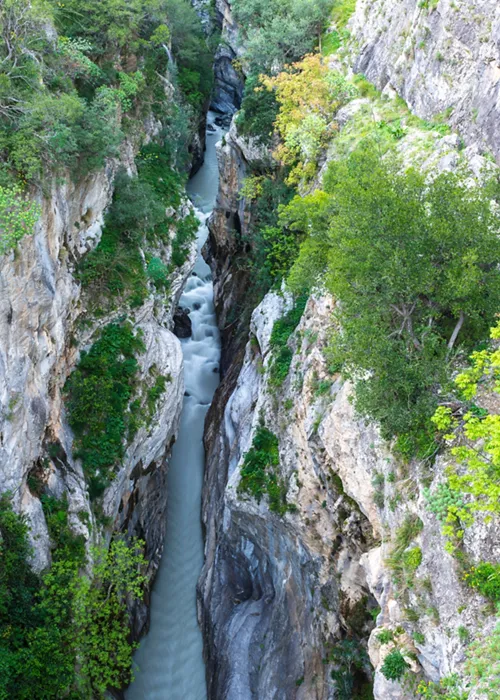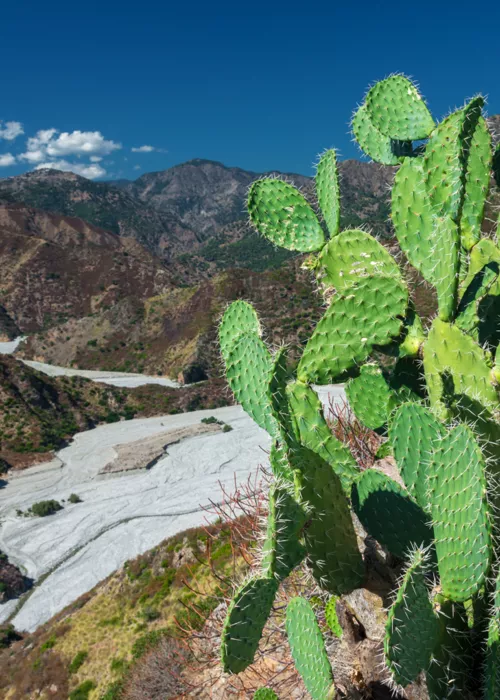Squillace, Badolato and Roccelletta di Borgia: Three delightful towns in central Calabria
9 minutes

Aside from its 800 km of coastline, Calabria is a mountainous region, and its geography has deeply influenced its history and culture. It is primarily in the inland areas that you find ancient hilltop villages, offering a vantage point for exploring the plains and the coast. If you wish to experience authentic Italy, we encourage you to keep reading… you won't be disappointed!
The village of Squillace: between legends and history
Built on a steep hill overlooking the large bay underneath, the town of Squillace boasts origins dating back as far as ancient Greece. Some people ascribe its foundation to Ulysses, while others believe it was founded by Menesteo, returning from the Trojan war. Conjectures apart, what's sure is that the settlement had Greek origins before it became part of the Roman Empire.
Top 5 things not to miss:
- The ruins of the Norman castle and the fantastic views from atop
- A stroll, up and down the alleys, in search of delightful details
- The Cathedral and life in the heart of the village
- Santa Chiara church and monastery
- The ancient art of ceramics
Squillace developed during the early Middle Ages, as the people fled on the hills to escape the Saracens and Langobard's incursions. Over the following centuries, the village underwent numerous dominations: Normans, Aragoneses, and even the Borgia family. Traces of Squillace's turbulent past are still visible all over the town.

The ruins of the Norman castle, built in 1044, mark the town's highest point. Unfortunately, a strong earthquake devastated Squillace in 1783 and destroyed many historical buildings. There's not much left of what must have been a magnificent fortress, but the ruins have an undisputed charm. Also, the 360° view from up there is astounding, stretching from the blue Jonian sea to the smooth hills and, farther away, the mountains.
I walked down the narrow alleys from the castle, stopping here and there to admire beautiful old buildings and portals (don't miss the baroque facade of Palazzo Olivieri) and delightful internal courtyards, especially the one of Palazzo Pepe. You need to go slowly and let your eyes wander to appreciate the beauty of Squillace.

Like in most Italian towns, many landmarks are religious buildings. The Normans originally built the Cathedral in 1096. After the 1783 earthquake, it was rebuilt in Romanesque style by local craftsmen. Its imposing structure dominates Squillace's main square, the heart of the town and the liveliest area
The ruins of the Santa Chiara church and the annexed monastery stand right below Piazza del Duomo. The complex was erected at the beginning of the 17th century and was severely damaged during the earthquake. Notwithstanding, it was one of my favourite sights in Squillace, perhaps the one which most tickled my imagination.
Santa Maria della Pietà is a tiny church hidden in the narrow alleys, whose gothic architecture is delightful. Unfortunately, I couldn't visit it inside. Still, if you get the chance, you should have a look at its internal architecture and the exquisite cross-vaulted ceilings.
Squillace is also famous for its ceramics, an art where the legacy from Ancient Greece is still alive. Over the centuries, the craftsmanship of Squillace's potters led to the production of remarkable objects, some of which are exhibited in important museums worldwide. As you walk along Corso Pepe and approach the castle, you'll see many ceramics shops, some displaying lovely external decorations. You might even see one of the potters at work if you're lucky. Their ability is simply fascinating.
There's no better way in the evening than chilling out at one of the bars - usually nothing fancy but very local and genuine. After that, an excellent dinner to taste local specialities, many of them based on vegetables and fish. After all, the hilltop village is only a few kilometres from the sea.
Roccelletta di Borgia: a stunning archaeological site

Like Squillace, Borgia did not escape the terrible 1783 earthquake. The village had to be almost entirely rebuilt, so I decided on a short visit, during which I spotted a few interesting buildings from the 19th century.
Top 5 things not to miss:
- A visit to the Musem to admire the archaeological finds.
- The majestic Basilica of Scolacium Archaeological Park
- Pop up in the Olive Mill Museum and learn about old techniques for olive oil production.
- Chill out at the lovely nearby beach in Copanello
- Admire the cliffs and Cassiodoro pools in Copanello di Stalettì
Don't be put off, though, as the jewel in the crown is the nearby Roccelletta di Borgia, housing the Scolacium Archaeological Park. Street signs were sometimes confusing, so it took me longer than expected to find the site. But it was worth the effort!
Visiting Scolacium is like journeying into the past, to the glorious times of the Magna Grecia and the Roman Empire. The Archaeological Park is set in an olive grove with many centuries-old trees, a rather unusual - and beautiful - setting. On a weekday at the end of September, there were only a few visitors, and wandering around in silence, Scolacium felt like a mystical place.
Before even walking into the park to see the ruins, I popped into the Museum. It houses artefacts found during the diggings and panels explaining the history of Scolacium and its architecture and is an excellent introduction to the archaeological site. The most impressive finds are the Roman marble sculptures and the gigantic bronze arm, belonging to a statue at least double the human size but never found.
The Romans founded the colony in 123 B.C. on the ruins of the Greek Skylletion. They named it Minervia Scolacium, in honour of the goddess of wisdom and war. Centuries later, the city would be the birthplace of Cassiodorus, the Roman statesman and founder of the Vivarium monastery. Thanks to Cassiodorus' enlightened vision, one of the monks' main activities was copying ancient manuscripts. As a result, the monastery played an essential role in preserving many old classical books.
I followed the itinerary in Scolacium Archaeological Park, leading to the main findings. There's the area where once stood the Roman Forum, the public space surrounded by administrative, commercial and religious buildings. Walking further, I reached the ruins of the theatre. It was built on a natural slope in the 1st century A.D. and later enlarged by Emperor Nerva. According to archaeologists, its terraces could host up to 3,500 spectators.

I continued along the path on a gentle slope to the amphitheatre. From there, I felt mesmerized by the views of the ruins immersed in the olive groves and, further away, the deep blue of the Jonian sea. The amphitheatre is the most recent finding in the Archaeological park. It is also remarkable for being the only one discovered in Calabria, at least to this day. The building could house up to 10,000 to 12,000 spectators, and its primary use was for gladiator performances.
The impressive ruins of Santa Maria della Roccella Basilica (also called La Roccelletta) at the park's edge are remarkable. The dating of the byzantine sanctuary, built in red bricks, is still being determined since it presents several layers and different architectural styles: Romanesque, Byzantine and Arab. However, some researchers say the Basilica could date back to the 11th or 12th century. To a visitor loving ancient art and architecture, this is a minor detail, for the ruins are majestic.
From Scolacium, I headed to the Cassiodoro pools in Copanello di Stalettì, a short 10-minute drive and one of the main attractions in the area. There, white granite cliffs slope gently into the crystal-clear turquoise sea water. It's a spot of great beauty, but its historical significance makes it unique. This is the place where Cassiodorus is said to have founded the Vivarium monastery around 555 A.D. According to historians, the name stems from the fish farm consisting of three basins dug into the rock. Cassiodorus himself used to transfer the fish caught in the sea to breed and dispose of for the monastery's needs. Unfortunately, the monastery was destroyed.
Nevertheless, it remains an evocative place, which the locals consider a significant testament to their glorious past.
Badolato Superiore: Charming medieval village between the sea and a verdant plateau.

About 35 kilometres south of Roccelletta di Borgia, Badolato is a charming medieval town standing atop a hill overlooking the Ionian sea. Its origins date back to 1080 when the Norman condottiere Robert Guiscard - who conquered southern Italy and Sicily - commissioned the building of Badolato castle.
Because of its strategic position, allowing the control of possible incursions from the sea and inland, Badolato was coveted by many rulers, alternating over the centuries to control the village. In addition to the political turmoil, the town endured multiple severe earthquakes and the inevitable damages. Notwithstanding, Badolato retained its medieval structure, with the typical narrow and curvy alleys.
Top 5 things not to miss:
- Get lost in the curvy alleys
- The mesmerizing view of Badolato from below
- The church of Immacolata, its beautiful architecture and the breathtaking panorama from its terrace
- The quaint decorations of some of the houses
- The Franciscan convent of Santa Maria degli Angeli, built on a close-by hill, for stunning views of Badolato.
I parked the car in Piazza Castello, the heart of the village, where the fortress once stood. Today, it's the primary gathering place for locals, meeting at the bars and restaurants in the square. I couldn't help noticing that that must be true in July and August because most places were closed at the end of September. The upside was that I had the village all by myself. Except for a handful of locals and tourists, I thoroughly enjoyed strolling up and down the lanes. I enjoyed the silence and felt as if time were suspended.

Badolato is known for its churches: no less than 14 in a village of fewer than 3,000 inhabitants. The one which most impressed me was the Chiesa dell'Immacolata. Dating back to the 17th century, the church sits on a terrace slightly outside the borgo, with breathtaking views of the cobalt blue gulf and the smooth hills dotted with olive trees. Unfortunately, the church was closed when I was there. Still, it is worth visiting, especially for the dome in byzantine style, appreciated for its beautiful decorations.
The borgo of Badolato is one of those towns that need to be discovered slowly. There's no better way to experience its charm than wandering in the alleys, taking in every little detail. I let my eyes linger on the old stone houses, the quaint exterior decorations and the perspective from some of the lanes, leading the sights to the sea, the hills or the lush Natural Regional Park of Serre.
Like many other small towns in Italy, in the 1980s, Badolato experienced significant depopulation. To avoid the risk that the village might become totally abandoned, Badolato became a town for sale. The initiative summoned the attention of many people, especially from northern Europe, who bought and renovated houses in this lovely town. Thus, don't get surprised if you meet "locals" speaking German or other foreign languages while strolling in the alleys.
Useful Information
Best time to go: July and August are the peak season; thus, expect this area of Calabria to be crowded. You'll need to book in advance and prepare for scorching days. April to June and September to October are the best options if you want milder temperatures and a calmer atmosphere. However, some hotels and restaurants are seasonal and close around mid-September. So your choices might be reduced.
Getting there: Lamezia Terme is the closest airport and also the nearest train station on the high-speed trains line. You'll need to rent a car to visit the hilltop villages since most are not served by public transportation.


